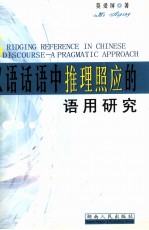图书介绍
汉语话语中推理照应的语用研究 a pragmatic appproachPDF|Epub|txt|kindle电子书版本下载

- 莫爱屏著 著
- 出版社: 长沙:湖南人民出版社
- ISBN:7543840138
- 出版时间:2005
- 标注页数:259页
- 文件大小:4MB
- 文件页数:292页
- 主题词:汉语-语用学-研究
PDF下载
下载说明
汉语话语中推理照应的语用研究 a pragmatic appproachPDF格式电子书版下载
下载的文件为RAR压缩包。需要使用解压软件进行解压得到PDF格式图书。建议使用BT下载工具Free Download Manager进行下载,简称FDM(免费,没有广告,支持多平台)。本站资源全部打包为BT种子。所以需要使用专业的BT下载软件进行下载。如BitComet qBittorrent uTorrent等BT下载工具。迅雷目前由于本站不是热门资源。不推荐使用!后期资源热门了。安装了迅雷也可以迅雷进行下载!
(文件页数 要大于 标注页数,上中下等多册电子书除外)
注意:本站所有压缩包均有解压码: 点击下载压缩包解压工具
图书目录
Chapter One Introduction1
1.1 The Goals of the Research2
1.2 The Rationale of the Research4
1.3 Main Issues and the Problem5
1.4 Methodology and Data Collection13
1.5 Overview of the Book14
Chapter Two Review of Past Studies19
2.1 Earlier Research on Bridging Reference20
2.2 Research on Bridging Reference in the 1980s26
2.3 More Recent Research on Bridging Reference30
2.4 Current Trends in Research on Bridging Reference34
2.5 Summary36
Chapter Three A Description of the Theoretical Framework38
3.1 The Delimitation of Bridging Reference39
3.1.1 The Mechanics of Bridging Reference39
3.1.2 The Working Definition of"Bridging Reference"40
3.1.2.1 A Review of Previous Definitions41
3.1.2.2 An Alternative Definition44
3.2 Principle of Relevance and Context46
3.2.1 Two Principles of Relevance Theory and Optimal Relevance47
3.2.2 Context50
3.3 Relevance Theory and Bridging Reference54
3.4 The Study of Bridging Reference at Three Levels58
3.4.1 The Syntactic Level59
3.4.2 The Semantic Level60
3.4.3 The Pragmatic Level61
3.5 Summary63
Chapter Four The Syntactic Analysis of Bridging Reference4.1 The Linguistic Elements of Discourse65
4.1.1 Parts of Sentence and Their Grammatical Functions65
4.1.2 Kinds of Word-forms in Chinese Discourse68
4.1.3 Major Carriers of Bridging Reference in Chinese Discourse71
4.1.3.1 Clause71
4.1.3.2 Sentence74
4.1.4 Logical Operators77
4.2 Information Structure and Syntactic Form81
4.2.1 Given/New Information82
4.2.2 Given/New Information and Syntactic Form84
4.3 Syntactic Constraints on Bridging Reference in Chinese Discourse87
4.3.1 Word Order and Constituent Order in Chinese Discourse88
4.3.2 Constraints of Word Order and Constituent Order on Bridging Reference91
4.4 Well-formedness and Syntactic Validity of Bridging Reference95
4.4.1 Well-formedness of Bridging Reference95
4.4.2 Syntactic Validity of Bridging Reference98
4.4.3 Syntactic Position of the Bridging Reference Relationship100
4.5 Summary106
Chapter Five The Semantic Analysis of Bridging Reference107
5.1 Theories of Meaning Relating to Bridging Reference108
5.2 Semantic Analysis of Bridging Reference110
5.2.1 Situational and Discourse Bridging Reference111
5.2.2 Meaning Relations and Truth-conditions in Discourse113
5.2.2.1 Entailment115
5.2.2.2 Semantic Presupposition117
5.2.3 The Semantics of the Verb,the Verb Phrase and the Adverbial in Bridging Reference Relationships121
5.3 Semantic Constraints on Bridging Reference122
5.3.1 The Constraint of Proposition on Bridging Reference123
5.3.2 The Constraint of Animate and Inanimate Entity on Bridging Reference127
5.3.3 The Constraint of Properties on Bridging Reference128
5.4 The Semantic Well-formedness and Acceptability of Bridging Reference131
5.4.1 The Semantic Well-formedness of Bridging Reference132
5.4.2 Semantic Acceptability of Bridging Reference135
5.5 Summary138
Chapter Six The Pragmatic Analysis of Bridging Reference140
6.1 Pragmatic Approaches to Bridging Reference141
6.1.1 Truth-based Approaches141
6.1.2 Coherence-based Approaches144
6.1.3 Relevance-based Approaches148
6.2 Pragmatic Constraints on Bridging Reference151
6.2.1 The Constraint of Stereotypicality151
6.2.2 The Pragmatic Constraint of Non-transitivity154
6.2.3 Pragmatic Constraint of Discourse Connectives on Bridging Reference157
6.3 Pragmatic Acceptability and Accessibility of Bridging Reference160
6.3.1 Bridging Reference and Bridging Inference161
6.3.2 Contextual Effects and Implicature in Interpreting Bridging Reference165
6.4 Towards a Unified Account of Bridging Reference169
6.4.1 Pragmatics vs.Syntax and Semantics in Bridging Reference169
6.4.1.1 Syntactic vs.Pragmatic Interpretation of Bridging Reference171
6.4.1.2 Semantic vs.Pragmatic Interpretation of Bridging Reference172
6.4.2 A Relevance-theoretic Account of Bridging Reference174
6.4.2.1 Sidner's Account:The Expected Focus Algorithm175
6.4.2.2 Topic/Focus Accounts and the Determination of Bridging Reference177
6.4.2.3 Pragmatic Presupposition and Appropriateness of Bridging Reference180
6.5 Summary184
Chapter Seven Testing the Hypotheses:Two Questionnaire Studies185
7.1 Questionnaire 1186
7.1.1 Participants186
7.1.2 Materials187
7.1.3 Procedures189
7.1.4 Data Preparation and Data Analysis189
7.1.5 Results and Discussion190
7.2 Questionnaire 2193
7.2.1 Participants193
7.2.2 Materials194
7.2.3 Procedures196
7.2.4 Data Preparation and Data Analysis196
7.2.5 Results and Discussion197
7.3 Summary202
Chapter Eight Conclusion and Implications203
8.1 Syntactic Well-formedness and Validity205
8.2 Semantic Well-formedness and Acceptability206
8.3 Pragmatic Appropriateness and Accessibility208
8.4 Implications of the Present Research210
8.5 Limitations and Issues Worth Further Consideration and Exploration211
Bibliography214
Appendix Ⅰ226
Appendix Ⅱ235
Appendix Ⅲ247
第一章 简介1
1.1 本研究的目的2
1.2 本研究的出发点4
1.3 本研究拟定解决的主要问题5
1.4 本研究的研究方法和语料13
1.5 本书概要14
第二章 文献回顾19
2.1 推理照应的早期研究20
2.2 推理照应在二十世纪80年代的研究26
2.3 推理照应近年来的研究30
2.4 推理照应研究的当代动向34
2.5 本章小结36
第三章 理论框架38
3.1 推理照应的界定39
3.1.1 推理照应的构成39
3.1.2 本研究对“推理照应”的界定40
3.1.2.1 对现存定义的回顾41
3.1.2.2 本研究的界定44
3.2 关联原则与语境46
3.2.1 关联理论和最佳关联47
3.2.2 语境50
3.3 关联理论和推理照应54
3.4 推理照应三个层面的研究58
3.4.1 句法层面59
3.4.2 语义层面60
3.4.3 语用层面61
3.5 本章小结63
第四章 推理照应的句法分析64
4.1 话语的构成成分65
4.1.1 句子成分及其语法功能65
4.1.2 汉语话语的词形68
4.1.3 汉语话语中推理照应的主要载体71
4.1.3.1 子句71
4.1.3.2 句子74
4.1.4 逻辑算子77
4.2 信息结构和句法形式81
4.2.1 新/旧信息82
4.2.2 新/旧信息和句法结构84
4.3 汉语话语中推理照应的句法制约因素87
4.3.1 汉语话语中的词序及语序88
4.3.2 词序及语序对推理照应的制约功能91
4.4 推理照应的合法性及句法有效性95
4.4.1 推理照应的合法性95
4.4.2 推理照应的句法有效性98
4.4.3 推理照应的句法位置100
4.5 本章小结106
第五章 推理照应的语义分析107
5.1 分析推理照应的意义理论108
5.2 推理照应的语义分析110
5.2.1 情景推理照应与话语推理照应111
5.2.2 话语中的意义关系与真值条件113
5.2.2.1 蕴涵115
5.2.2.2 语义预设117
5.2.3 推理照应关系中的动词、动词短语及状语的语义分析121
5.3 推理照应的语义制约因素122
5.3.1 命题对推理照应的制约功能123
5.3.2 有生命性及无生命性对推理照应的制约功能127
5.3.3 特性对推理照应的制约功能128
5.4 推理照应的语义合法性及可接受性131
5.4.1 推理照应的语义合法性132
5.4.2 推理照应的语义可接受性135
5.5 本章小结138
第六章 推理照应的语用分析140
6.1 推理照应研究的语用方法141
6.1.1 真值论141
6.1.2 连贯论144
6.1.3 关联论148
6.2 推理照应的语用制约因素151
6.2.1 常规关系的制约功能151
6.2.2 非及物性的语用制约功能154
6.2.3 话语标记语对推理照应的语用制约功能157
6.3 推理照应的语用可接受性及可及性160
6.3.1 语用照应与语用推理161
6.3.2 推理照应的语境效果及暗含165
6.4 推理照应之合理解释169
6.4.1 推理照应的语用与句法及语义之对比169
6.4.1.1 推理照应的句法与语用之对比171
6.4.1.2 推理照应的语义与语用之对比172
6.4.2 推理照应的关联论解释174
6.4.2.1 Sidner的研究:意想焦点法175
6.4.2.2 主题/焦点法与推理照应的确定177
6.4.2.3 语用预设与推理照应的适切性180
6.5 本章小结184
第七章 假设检验:两个问卷调查185
7.1 问卷1186
7.1.1 参与者186
7.1.2 语料187
7.1.3 本问卷调查过程189
7.1.4 语料收集及分析189
7.1.5 结果与讨论190
7.2 问卷2193
7.2.1 参与者193
7.2.2 语料194
7.2.3 本问卷调查过程196
7.2.4 语料收集及分析196
7.2.5 结果与讨论197
7.3 本章小结202
第八章 结论与启示203
8.1 句法合法性与有效性205
8.2 语义合法性与可接受性206
8.3 语用适切性与可及性208
8.4 本研究的启示210
8.5 本研究的不足及值得进一步探讨的问题211
参考书目214
附录Ⅰ226
附录Ⅱ235
附录Ⅲ247